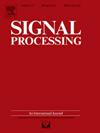When non-local similarity meets tensor factorization: A patch-wise method for hyperspectral anomaly detection
IF 3.4
2区 工程技术
Q2 ENGINEERING, ELECTRICAL & ELECTRONIC
引用次数: 0
Abstract
Hyperspectral anomaly detection (HAD) entails identifying anomaly pixels in hyperspectral images (HSI) that significantly diverge from the background spectral signatures. However, the conventional tensor-based HAD methods typically leverage tensor nuclear norm (TNN) and its variants to exploit the low-rank characteristic on the image-level HSI. Specifically, the omission of non-local similarity features in HAD reduces the potential to leverage pertinent information, leading to the loss of crucial HSI structures and details. In addition, the tensor singular value decomposition (t-SVD) involved in solving the TNN minimization tends to augment the computational time as the data size expands. To address these issues, a novel patch-wise model for HAD that integrates non-local similarity with tensor factorization (NSTF) is proposed. Specifically, instead of using the entire image, we employ aggregated non-local similarity patches to characterize the low-rank structure of HSI, accounting for both spectral correlation and non-local similarity simultaneously and equivalently. Moreover, we introduce tensor factorization to factorize the large-scale tensor generated by grouping non-local similarity patches into two small-scale tensors, which more efficiently exploits its low-rank property of background. Finally, comprehensive experimental results validated on HSI datasets unequivocally establish the superiority of our proposed method over cutting-edge methods.
求助全文
约1分钟内获得全文
求助全文
来源期刊

Signal Processing
工程技术-工程:电子与电气
CiteScore
9.20
自引率
9.10%
发文量
309
审稿时长
41 days
期刊介绍:
Signal Processing incorporates all aspects of the theory and practice of signal processing. It features original research work, tutorial and review articles, and accounts of practical developments. It is intended for a rapid dissemination of knowledge and experience to engineers and scientists working in the research, development or practical application of signal processing.
Subject areas covered by the journal include: Signal Theory; Stochastic Processes; Detection and Estimation; Spectral Analysis; Filtering; Signal Processing Systems; Software Developments; Image Processing; Pattern Recognition; Optical Signal Processing; Digital Signal Processing; Multi-dimensional Signal Processing; Communication Signal Processing; Biomedical Signal Processing; Geophysical and Astrophysical Signal Processing; Earth Resources Signal Processing; Acoustic and Vibration Signal Processing; Data Processing; Remote Sensing; Signal Processing Technology; Radar Signal Processing; Sonar Signal Processing; Industrial Applications; New Applications.
 求助内容:
求助内容: 应助结果提醒方式:
应助结果提醒方式:


